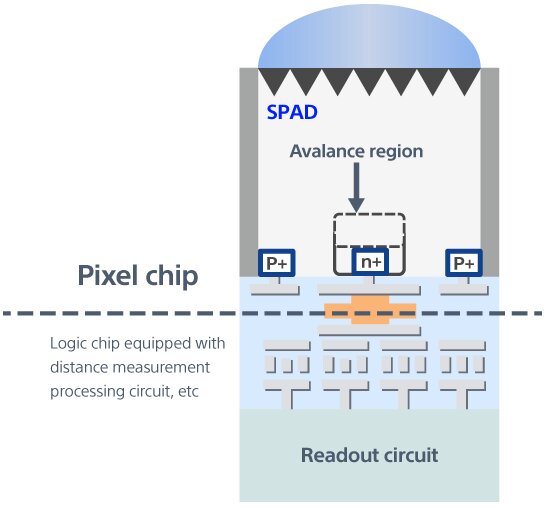Sony's IMX611 is a new direct time-of-flight (dToF) sensor developed for smartphones, which, with an adapted pixel structure, is said to have the highest efficiency to date in detecting photons. Sony also mentions improvements in energy consumption. The sensor could be for the iPhone 15 Pro (Max).
The new dToF sensor was developed by Sony Semiconductor Solutions Corporation (SSS) and, according to the provider, is currently being sampled for 1,000 yen per unit, i.e. just under 7 euros. The IMX611 uses a proprietary “single-photon avalanche diode” (SPAD) pixel structure, which is said to offer advantages in power consumption and distance measurement. The sensor was designed for use in connection with smartphone cameras in order to optimize the autofocus in poor lighting conditions, calculate a bokeh effect for portrait shots, record rooms in three dimensions or carry out calculations for augmented reality. The IMX611 should also be useful for the evolution of VR HMDs and AR glasses.
Highest efficiency in photon identification
Among the time-of-flight sensors developed specifically for smartphones, Sony advertises the IMX611 with the highest efficiency to date of 28 percent in detecting photons when using a laser light source with a wavelength of 940 nm, which Sony says is common in smartphones may be. Sony specifies the power consumption for the sensor alone as 110 mW for measurements from a distance of 8 m, and 160 mW for the entire system with a laser light source. At a short distance (3 m), consumption is 40 mW (sensor) and 85 mW (system). According to Sony, the error rate when measuring distances is less than 0.1 percent.
Pixel and logic chip in one package
Sensors like the IMX611 capture photons reflected from objects and use that information to calculate distance. In order to also be able to detect particularly weak photons and to still be able to carry out the distance measurement even with a weak laser light source, Sony relies on a light incidence level on the pixe chip that is deliberately provided with irregularities in order to break up the incident light and thus ensure a higher absorption rate. In the so-called avalanche region of the pixel, where the avalanche effect can be brought about, there have also been optimizations for efficient multiplication. In the multiplication zone, the number of free charge carriers increases like an avalanche, hence the name.

A copper-to-copper connection is used for the transfer from the pixel to the logic chip, with the data also being processed in the logic chip in order to once again increase efficiency. The raw data of the SPAD pixels are converted into distance information in the logic chip and then to a corresponding output, so that the load for later post-processing is reduced.
Sensor might be intended for iPhone 15 Pro
The IMX611 could be used for the first time in the Apple iPhone 15 Pro and iPhone 15 Pro Max, which are expected for late summer. Sony itself does not name any buyers for the sensor, but the analyst Ming-Chi Kuo, who is often correct in his statements, reported from supplier circles at the end of February that Apple for the two new smartphones for the dToF sensor from Lumentum (design) and Win Semi (Production) will be switching exclusively to Sony.
Recommended external content  Twitter
Twitter
This is an external content from Twitter , which complements the article and is recommended by the editors. It can be loaded with one click and also hidden again.
Load Twitter Embeds I consent to loading Twitter Embeds. Personal data can be transmitted to Twitter. More on this in the data protection declaration.
(2/7)
1. The critical design of Sony's ToF VCSEL solution is integrating VCSEL & driver IC, which can reduce power consumption (beneficial for battery life) or provide better ToF performance under same power consumption (beneficial for camera & potential AR applications).—郭明錤 (Ming-Chi Kuo) (@mingchikuo) February 24, 2023
Load Twitter embeds Privacy Policy
Sony is said to have a sensor with an integrated VCSEL (vertical-cavity surface-emitting laser), i.e. with an integrated laser diode that emits the light perpendicular to the plane of the semiconductor chip. According to Kuo, Sony should deliver a more efficient and powerful sensor to Apple, which would apply to the IMX611.

